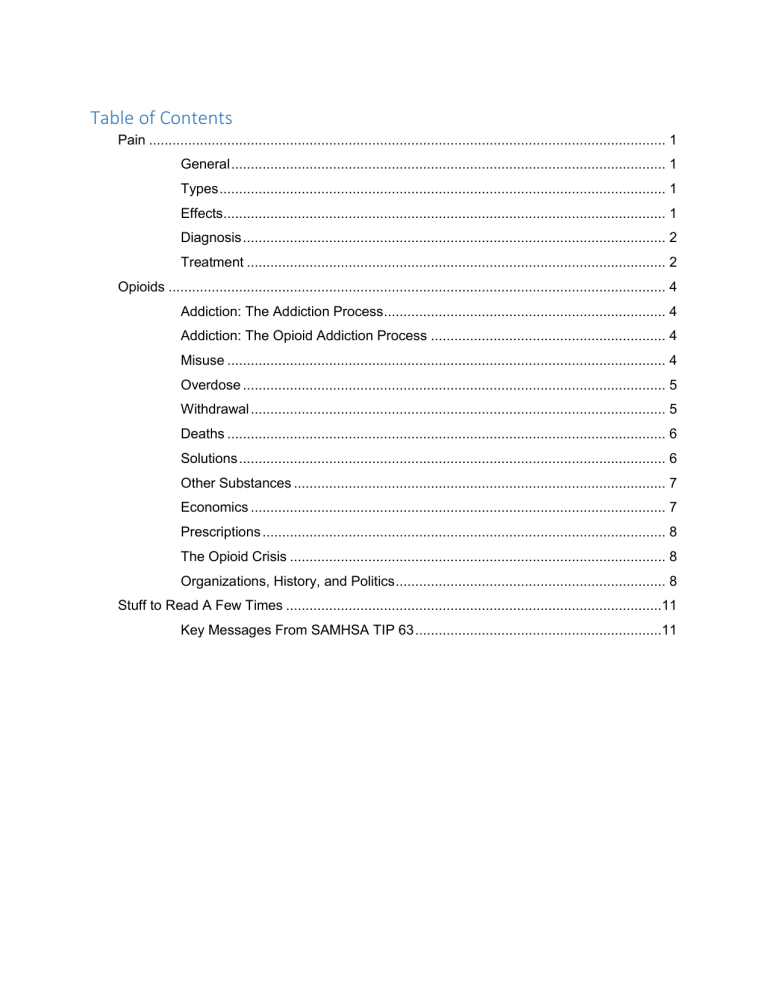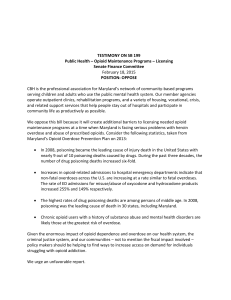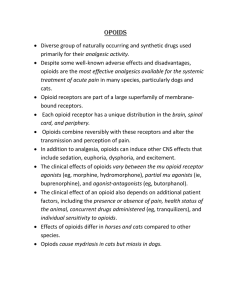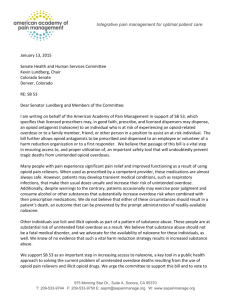
Table of Contents Pain .................................................................................................................................... 1 General ............................................................................................................... 1 Types .................................................................................................................. 1 Effects................................................................................................................. 1 Diagnosis ............................................................................................................ 2 Treatment ........................................................................................................... 2 Opioids ............................................................................................................................... 4 Addiction: The Addiction Process........................................................................ 4 Addiction: The Opioid Addiction Process ............................................................ 4 Misuse ................................................................................................................ 4 Overdose ............................................................................................................ 5 Withdrawal .......................................................................................................... 5 Deaths ................................................................................................................ 6 Solutions ............................................................................................................. 6 Other Substances ............................................................................................... 7 Economics .......................................................................................................... 7 Prescriptions ....................................................................................................... 8 The Opioid Crisis ................................................................................................ 8 Organizations, History, and Politics ..................................................................... 8 Stuff to Read A Few Times ................................................................................................11 Key Messages From SAMHSA TIP 63 ...............................................................11 1 Pain General Nearly any part of your body is vulnerable to pain. In addition, the brain’s opioid system, which includes naturally occurring opioid molecules (i.e., endorphins, enkephalins, and dynorphins) and three types of opioid receptors (i.e., mu, delta, and kappa), plays a key role in mediating the rewarding effects of other addictive substances, including opioids and alcohol The belief that pain is an inevitable part of the human condition is widespread But for the estimated 100 million Americans currently living with chronic pain, more than half report little to no control over their pain. About 9 in 10 Americans regularly suffer from pain, and pain is the most common reason individuals seek health care Sufficient knowledge and resources exist to manage pain in an estimated 90% of individuals with acute or cancer pain. Data from a 1999 survey suggest that only 1 in 4 individuals with pain receive appropriate therapy. Acute pain is the most common reason why patients seek medical attention. Types Classified By Duration of Pain: Acute pain typically comes on suddenly and has a limited duration. It's frequently caused by damage to tissue such as bone, muscle, or organs, and the onset is often accompanied by anxiety or emotional distress Chronic pain lasts longer than acute pain and is generally somewhat resistant to medical treatment. It's usually associated with a long-term illness, such as osteoarthritis. In some cases, such as with fibromyalgia, it's one of the defining characteristic of the disease. Chronic pain can be the result of damaged tissue, but very often is attributable to nerve damage. Classified By Kind of Damage Which Causes It: Tissue/Nociceptive Pain: pain caused by tissue damage o Feels like a sporadic or continuous aching, sharp stabbing, or throbbing. o Most pain comes from tissue damage. Nerve/Neuropathic Pain: pain caused by nerve damage o Feels like burning or prickling, sometimes further set off by hypersensitivity. o Most is chronic. Psychogenic Pain: pain affected by psychological factors, most often originating from other pain. Classified By Type of Tissue Involved (Example) Muscular Pain (Example) Joint Pain Classified By Part of Body Affected (Example) Chest Pain (Example) Back Pain Effects 2 Pain can affect and be affected by a person's state of mind. Pain can include a feedback loop of physical pain and psychological consequences. Breakthrough pain refers to flares of pain that occur even when pain medication is being used regularly. Can be set off spontaneously or when medication wears off. Diagnosis Questions Medical History Current Health Condition o Pain Assessment o Physical Examination Tests CT (Computed tompography) Scan o Using x-rays and computers, this produces an image of a cross-section of the body MRI (Magnetic Resonance Imaging) o Without the use of x-rays, large magnet radio waves and computers make images. Nerve Blocks o Injecting anesthetics to nerve locations for numbing pain in order to find source of pain Discography o For pre-decision of back pain surgery, dye injected into disk thought to cause pain which outlines damaged areas in x-rays Myelogram o For back pain, a dye is injected into the spinal canal which aids in identifying nerve compression EMG (Electromyogram) o Fine needles placed in muscles which measure response to electrical signals Bone Scans o Radioactive material injected into the bloodstream collects particularly in abnormal bone areas. Ultrasound Imaging/Sonography o High frequency sound waves which create images of the inside of the body. Treatment Components of an Effective Treatment Plan: 1. The goals of treatment 2. Possible constituents of the treatment plan 3. Patient/HCP Interaction Psychological: Cognitive behavioral therapy Physical: Physical Therapy 3 Exercise Acupuncture (decreases pain by increased release of endorphins when acu-points near nerves stimulated) Massage/Chiropractic Treatment Consumptive: Dietary o Nutritional Supplements o Herbal Remedies Drug Therapy: o Non-prescription/Over-the-counter o Prescription o Patient-controlled analgesia (a pump button which allows patients to selfadminister a premeasured dose of pain medicine) o Nerve Block o Anesthesia Trigger Point Injections (injection of a local anesthetic sometimes with a steroid into a trigger point) Surgical Implants/Interventional Techniques Intrathecal Drug Delivery/Infusion Pain Pumps/Spinal Drug Delivery Systems (a pump and catheter inserted under a pocket of skin for the direct and significantly more effective/efficient administration of medicines directly to the spinal cord) Spinal Cord Stimulation Implants (low-level electrical signals are transmitted to the spinal cord or specific nerves to block pain signals from reaching the brain through a device surgically implanted in the body with a remote control used by the patient) TENS: (Transcutaneous Electrical Nerve Stimulation Therapy, electrical stimulation of nerves in affected area through a current applied on skin.) Bioelectric Therapy: (blocks pain messages to brain and increases endorphins) 4 Opioids Addiction: The Addiction Process The addiction process involves a three-stage cycle: 1. Binge/Intoxication, the stage at which an individual consumes an intoxicating substance and experiences its rewarding or pleasurable effects; 2. Withdrawal/Negative Affect, the stage at which an individual experiences a negative physical and emotional state in the absence of the substance; and 3. Preoccupation/ Anticipation, the stage at which one seeks substances again after a period of abstinence. Addiction: The Opioid Addiction Process 1. intense intoxication 2. the development of tolerance 3. escalation in use 4. withdrawal signs Misuse Opioids can depress critical areas in the brain that control breathing, heart rate, and body temperature and cause them to stop functioning. Substance use and misuse becomes increasingly likely across adolescence, with rates peaking among people in their twenties, and declining thereafter. It is common for people who misuse opioids to misuse other substances or to have multiple substance use disorders, childhood trauma, or co-occurring physical and mental disorders. In 2014, more than 47,000 people died from a drug overdose. Included in this number are nearly 30,000 people who died from an overdose involving prescription drugs. This is more than in any previous year on record. In 2015, over 27.1 million people were current users of illicit drugs or misused prescription drugs. Lifetime: 36 million persons (13.6%) aged 12 or older have misused pain relievers in their lifetime. Past Year: 12.5 million persons (4.7 %) aged 12 or older have misused pain relievers in the past year. • OxyContin®: 1.7 million persons (0.7%) aged 12 or older have used OxyContin® non-medically in the past year. In 2015, 20.8 million people aged 12 or older in the United States had a substance use disorder About 11.1 million people aged 12 and older had misused prescription pain relievers in the past year. (2017) About 2.3 million people age 12 and older misused prescription opioids or heroin for the first time (2017) About 1.7 million people aged 12 and older had a prescription pain reliever use disorder in the past year. (2017) --Only 28.6 percent of those aged 12 and older with an opioid use disorder in the past year received treatment for illicit drug use at a specialty treatment facility. Heroine o About 953,000 people received treatment for the misuse of opioid pain relievers. (2017) 5 o About 886,000 people aged 12 or older reported having used heroin in the past year. (2017) o 652,000 people aged 12 or older were estimated to have a heroin use disorder. (2017) o Only 54.9 percent of those aged 12 and older with heroin use disorder received treatment for illicit drug use at a specialty treatment facility. About one in four people (28.6 percent) with this opioid use disorder received specialty treatment for illicit drug use in the past year. About 12.2 percent of adults who need treatment for a substance use disorder receive any type of specialty treatment. In 2015, nearly 7.7 million people needed treatment for an illicit drug use disorder (3.8 percent for men and 2.0 percent for women). Additionally, 45.5 percent of people with a substance use disorder also have a mental disorder, yet only about half (51.0 percent) receive treatment for either disorder and only a small minority receive treatment for both. However, clinical reports suggest that women who use cocaine, opioids, or alcohol progress from initial use to a disorder at a faster rate than do men (called “telescoping”). OPIOID-RELATED inpatient hospital stays INCRdEASED 64% nationally from 2005–2014.2 OPIOID-RELATED EMERGENCY DEPARTMENT visits nearly doubled from 2005–2014 Overdose Signs o slow breathing o blue lips and fingernails o cold damp skin o shaking o vomiting or gurgling noise Prevention Strategies o Encourage providers and others to learn how to prevent and manage opioid overdose. o Ensure access to treatment for individuals who have a substance use disorder. o Ensure ready access to naloxone. o Encourage the public to call 911 o Encourage prescribers to use state prescription drug monitoring programs Withdrawal Signs o Early Withdrawal is 8-24 or 0-36 hours for short- and long-acting opioids. Grade 1: Yawning, restlessness, insomnia Grade 2: Dilated pupils, muscle twitching, abdominal pain o Fully Developed Withdrawal is 1-3 or 3-4 days for short- and long-acting opioids. Grade 3: Hypertension, fever, anorexia or nausea, extreme restlessness 6 Grade 4: Diarrhea, vomiting, dehydration, hypotension, curled-up position Newborns may experience NAS, a withdrawal syndrome following exposure to drugs while in the mother’s womb Deaths To curb the rise in opioid overdose deaths, CDC recommends screening for substance use and substance use disorders before and during the course of opioid prescribing for chronic pain, combined with patient education. Deaths in 2016 were 63,632 from drug/opioid overdoses. disabled Medicare beneficiaries, who accounted for nearly 25 percent of opioid overdose deaths in 2008. Opioids were involved in 42,249 deaths in 2016—more than 115 deaths every day, on average. 47,872 people died from an opioid overdose in 2017. Opioid overdose deaths were five times higher in 2016 than in 1999. The majority of these opioid overdose deaths were unintentional. In 2014, 47,055 drug overdose deaths occurred in the United States, and 61 percent of these deaths were the result of opioid use, including prescription opioids and heroin. Heroin overdoses have more than tripled from 2010 to 2014.7 Heroin overdoses were more than five times higher in 2014 (10,574) then ten years before in 2004 (1,878). The opioid misuse and overdose crisis touches everyone in the United States. In 2016, we lost more than 115 Americans to opioid overdose deaths each day, devastating families and communities across the country. Preliminary numbers in 2017 show that this number continues to increase with more than 131 opioid overdose deaths each day. Opioid overdose caused 42,249 DEATHS nationwide in 2016— this exceeded the # caused by motor vehicle crashes. In addition, alcohol is involved in about 20 percent of the overdose deaths related to prescription opioid pain relievers. By 2016, men accounted for 67.5% of all opioid-related deaths, and the median (interquartile range) age at death was 40 (30-52) years. Solutions Alternatives The alternatives mentioned in the cards Methadone o is a synthetic opioid agonist that has been used to treat the symptoms of withdrawal from heroin and other opioids. More than 40 years of research support the use of methadone as an effective treatment for opioid use disorder. It is also used in the treatment of patients with chronic, severe pain as a therapeutic alternative to morphine sulfate and other opioid analgesics. Many people, including some policymakers, authorities in the criminal justice system, and 7 treatment providers, have viewed maintenance treatments as “substituting one substance for another o Today, methadone treatment programs, now called Opioid Treatment Programs (OTPs), must be certified by SAMHSA and registered by the U.S. Drug Enforcement Administration (DEA). Safe use of opioids Safe storage Dosing instruction Proper disposal of used and unused opioids Naloxone Prevention The Institute of Medicine (IOM), now known as the National Academy of Medicine, has described three categories of prevention interventions: universal, selective, and indicated. With respect to substance use interventions, universal interventions are aimed at all members of a given population (for instance, population-level strategies); selective interventions are aimed at a subgroup determined to be at high-risk for substance use (for instance, justice-involved youth); and indicated interventions are targeted to individuals who are already using substances but have not developed a substance use disorder Other Substances Nearly 80 percent of people addicted to heroin started first with prescription opioids. However, the transition to heroin use from prescription opioids is still rare; only about 4 percent of people who misuse prescription opioids use heroin. nearly 80 percent of recent heroin initiates reported that they began their opioid use through the nonmedical use of prescription opioid medications.” Although only about 4 percent of those who misuse prescription opioids transition to using heroin More than 80 percent of patients who are opioid dependent smoke cigarettes. An estimated 1.8M AMERICANS have opioid user disorder (OUD) related to opioid painkillers; 2.1 MILLION people in the U.S., ages 12 and older, had opioid user disorder (OUD) involving PRESCRIPTION OPIOIDS, HEROIN, or both in 2016. Economics Substance misuse and substance use disorders cost the U.S. more than $442 billion annually in crime, health care, and lost productivity. These costs are almost twice as high as the costs associated with diabetes, which is estimated to cost the United States $245 billion each year. Alcohol misuse and alcohol use disorders cost the United States approximately $249 billion in lost productivity, health care expenses, law enforcement, and other criminal justice costs. The costs associated with misuse of illegal drugs and non-prescribed medications and drug use disorders were estimated to be more than $193 billion in 2007 Pain costs Americans an estimated $100 billion each year 8 The effects of the opioid crisis are cumulative and costly for our society—an estimated $504 billion a year in 2015—placing burdens on families, workplaces, the health care system, states, and communities. Substance misuse and substance use disorders are estimated to cost society $442 billion each year in health care costs, lost productivity, and criminal justice costs. Estimated cost of the OPIOID EPIDEMIC was $504 BILLION in 2015 Prescriptions Only about 21.5 percent of people with opioid user disorder (OUD) received treatment from 2009 to 2013.8 731.2 Opioid prescriptions per 1,000 people nationwide The over-prescription of powerful opioid pain relievers was associated with a rapid escalation of use and misuse of these substances. The good news is that a decrease in the amount of opioid pain relievers prescribed has been reported.20 However, the amount of opioids prescribed in 2015 remained approximately three times higher than in 1999 and varied substantially across the country. Opioid analgesic pain relievers are now the most prescribed class of medications in the United States, with more than 289 million prescriptions written each year.4 For example, a recent study found that doctors continue to prescribe opioids for 91 percent of patients who suffered a non-fatal overdose, with 63 percent of those patients continuing to receive high doses; 17 percent of these patients overdosed again within 2 years. Prescribing opioids for over a week for acute pain doubles the risk of long-term use at one year (6% to 13%) and this risk doubles again (to 29.9%) if the initial prescription lasts a month. In Australia in 2013, over 15 million packs of over the counter opioids were sold. Accounting for 36.6% of total opioid pack sales. The Opioid Crisis The opioid crisis is being driven by three trends: (1) an increase of prescription opioid overdose deaths since 1999; (2) the four-fold increase in heroin overdoses since 2010; and (3) the tripling death rate for synthetic opioids like fentanyl since 2013 Overdose deaths from opioid pain relievers and heroin have risen dramatically in the past 14 years,80 from 5,990 in 1999 to 29,467 in 2014, and most were preventable. Organizations, History, and Politics SAMHSA- Substance Abuse and Mental Health Services Administration HRSA- Health Resources and Services Administration AHRQ- Agency for Healthcare Research and Quality CMS- Centers for Medicare and Medicaid Services IOM-Institute of Medicine/ NAM- National Academy of Medicine USPSTF- US Preventive Services Task Force NIDA- National Institute on Drug Abuse U.S. Department of Health and Human Services (HHS) 9 In April 2017, federal legislation was introduced to limit the supply of opioid prescription for acute pain to 7 days. By August 2017, 24 states have enacted legislation with a limit guidance, or requirement related to opioid prescribing. ***HHS also brought a new level of awareness and commitment to the cause by declaring the opioid crisis a nationwide Public Health Emergency on October 26, 2017. HHS has invested $2 billion in opioid-specific funding for states, which encompasses the State Targeted Response (STR) to the Opioid Crisis and the State Opioid Response (SOR) grant programs administered by SAMHSA Since January 2017, over 200 health centers have been engaged in a HRSAfunded technical assistance opportunity through the Opioid Addiction Treatment Extension for Community Healthcare Outcomes project, a virtual, national technical assistance effort to enhance health center capacity to treat substance misuse. The National Institutes of Health (NIH), in collaboration with other federal agencies, is developing a study as part of the Helping to End Addiction Long-term (HEAL) Initiative called the HEALing Communities Study. This comprehensive study will test the implementation of an integrated set of addiction prevention and treatment approaches across healthcare, behavioral health, justice systems, state and local governments, and community organizations to prevent and treat opioid misuse and opioid use disorder. The Agency for Healthcare Research and Quality (AHRQ) in investing in research grants to discover how to best support primary care practices and rural communities in delivering MAT for opioid use disorders The HHS Center for Faith-Based and Neighborhood Partnerships created the Opioid Epidemic Practical Toolkitto equip local communities—lay persons, faith groups, nonprofits, and health care providers—with practical steps to bring hope and healing to the millions suffering the consequences of opioid misuse. some studies have begun to examine the impact of prescription drug monitoring programs (PDMPs) on misuse of prescription medications.245 These state-initiated policies are designed to curb the rate of inappropriate prescribing of opioid pain relievers through various methods. Data from the U.S. Drug Enforcement Administration’s (DEA’s) Automation of Reports and Consolidated Orders System (ARCOS)246 showed little impact of these monitoring systems, perhaps because of the variability of the policies controlling different state systems. Some studies associate state PDMPs with lower rates of prescription drug misuse and altered prescribing practices, although evidence is mixed and inconclusive.247 One reason for inconsistent findings may be low and variable prescriber utilization of PDMPs. A 2016 study found that the implementation of a PDMP was associated with 1.12 fewer opioid-related overdose deaths per 100,000 people in the year immediately after the program was implemented, and if every state in the United States had a robust PDMP, there would be an estimated 600 fewer overdose deaths per year In one of the most rigorous studies to date, Florida’s simultaneous institution of a prescription drug monitoring system and “pill mill” control policies was compared to Georgia, a state without either policy. This study demonstrated “modest reductions in total opioid volume, mean morphine milligram equivalent per transaction, and total number of opioid prescriptions dispensed, but no effect on duration of treatment. These 10 reductions were generally limited to patients and prescribers with the highest baseline opioid use and prescribing.” In 2016, SAMHSA also provided $11,000,000 in funding to prevent prescription drug/opioid overdose-related deaths among individuals aged 18 or older by training first responders and other community stakeholders on prevention strategies. Thirty-seven states and the District of Columbia have “Good Samaritan” statutes that prevent prosecution for possession of a controlled substance or paraphernalia if emergency assistance is sought for someone who is experiencing an overdose, including an opioid-induced overdose. 11 Stuff to Read A Few Times Behavioural, physical, and psychological treatments may be beneficial to some patients suffering from chronic pain. Physicians should move away from ‘quick fixes’ and instead turn to long term therapies other than opioids. The Opioid Crisis. Over-prescription of powerful opioid pain relievers beginning in the 1990s led to a rapid escalation of use and misuse of these substances by a broad demographic of men and women across the country.1 This led to a resurgence of heroin use, as some users transitioned to using this cheaper street cousin of expensive prescription opioids. As a result, the number of people dying from opioid overdoses soared—increasing nearly four-fold between 1999 and 2014.4 Key Messages From SAMHSA TIP 63 Addiction is a chronic, treatable illness General principles of good care for chonics diseases can guide OUD (Opioid Use Disorder) treatment Patient-centered care empowers patients with information that helps them make better treatment decisions with the healthcare professionals involved in their care. Patients with OUD should have access to mental health services as needed, medical care, and addiction counseling, as well as recovery support services, to supplement treatment with medication. There is no “one size fts all” approach to OUD treatment. The science demonstrating the effectiveness of medication for OUD is strong. This doesn’t mean that remission and recovery occur only through medication Medication for OUD should be successfully integrated with outpatient and residential treatment. Patients treated with medications for OUD can beneft from individualized psychosocial supports Expanding access to OUD medications is an important public health strategy. Improving access to treatment with OUD medications is crucial to closing the wide gap between treatment need and treatment availability, given the strong evidence of effectiveness for such treatments. Data indicate that medications for OUD are cost effective and cost benefcial. Increasing opioid overdose deaths, illicit opioid use, and prescription opioid misuse constitute a public health crisis. OUD medications reduce illicit opioid use, retain people in treatment, and reduce risk of opioid overdose death better than treatment with placebo or no medication. • Only physicians, nurse practitioners, and physician assistants can prescribe buprenorphine for OUD. They must get a federal waiver to do so. Only federally certifed, accredited opioid treatment programs (OTPs) can dispense methadone to treat OUD. OTPs can administer and dispense buprenorphine without a federal waiver. Any prescriber can offer naltrexone. 12 OUD medication can be taken on a shortor long-term basis, including as part of medically supervised withdrawal and as maintenance treatment. Patients taking medication for OUD are considered to be in recovery. Several barriers contribute to the underuse of medication for OUD All healthcare practices should screen for alcohol, tobacco, and other substance misuse (including opioid misuse). Validated screening tools, symptom surveys, and other resources are readily available; this part lists many of them. When patients screen positive for risk of harm from substance use, practitioners should assess them using tools that determine whether substance use meets diagnostic criteria for a substance use disorder (SUD). Thorough assessment should address patients’ medical, social, SUD, and family histories. Laboratory tests can inform treatment planning. Practitioners should develop treatment plans or referral strategies (if onsite SUD treatment is unavailable) for patients who need SUD treatment. OUD medications are safe and effective when used appropriately. OUD medications can help patients reduce or stop illicit opioid use and improve their health and functioning. Pharmacotherapy should be considered for all patients with OUD. Reserve opioid pharmacotherapies for those with moderate-to-severe OUD with physical dependence. Patients with OUD should be informed of the risks and benefts of pharmacotherapy, treatment without medication, and no treatment. Patients should be advised on where and how to get treatment with OUD medication. Doses and schedules of pharmacotherapy must be individualized. Many patients taking OUD medication beneft f rom counseling as part of their treatment. Counselors play the same role for clients with OUD who take medication as for clients with any other SUD. Counselors help clients recover by addressing the challenges and consequences of addiction. OUD is often a chronic illness requiring ongoing communication among patients and providers to ensure that patients fully beneft f rom both pharmacotherapy and psychosocial treatment and support. OUD medications are safe and effective when prescribed and taken appropriately. Medication is integral to recovery for many people with OUD. Medication usually produces better treatment outcomes than outpatient treatment without medication. Supportive counseling environments for clients who take OUD medication can promote treatment and help build recovery capital. 13 https://opioids.thetruth.com/o/quizzes/opioids 1. Pain causes stress, and when combined with the inflammation process it can produce: A. weight loss. B. weight gain. C. ulcers. D. acne. 2. The most common opioid side effects include all of the following, EXCEPT: A. loss of consciousness. B. nausea. C. vomiting. D. mild sedation. 3. Experts recommend that patients suffering from chronic back and arthritis pain should try what first? A. opioids. B. exercise. C. aspirin. D. nutritional supplements. Summaries like these appear to be REALLY good from experience: https://www.mayoclinicproceedings.org/article/S0025-6196(17)30923-0/pdf http://americanpainsociety.org/uploads/education/section_1.pdf 2,975 seizures of illicit opioids in 2017 Average Age of Initiation Prescription Opioids: 25.8




